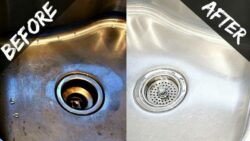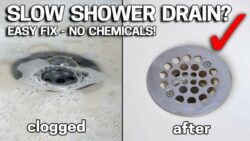Dealing with a clogged toilet can be really tough, like when the flush handle doesn’t work. This guide will teach you how to use a toilet plunger well. You’ll learn the right techniques and tools to fix clogs easily.
Knowing how to use a plunger can save you from bigger plumbing problems. We’ll cover different types of plungers and share useful tips. You’ll become a pro at fixing toilet blockages. Let’s get into the details and be ready for any plumbing issue.
Key Takeaways
- Using a flange plunger is recommended for toilets, while cup plungers are better suited for sinks.
- Maintaining a tight seal around the drain is key for removing clogs effectively.
- Hot water can help when plunging, making stubborn clogs easier to remove.
- Proper plunging techniques involve using firm pressure and quick motions to dislodge blockages.
- Routine maintenance and smart usage of toilet paper can prevent future clogs.
Understanding Different Types of Toilet Plungers
Knowing the different types of toilet plungers can greatly improve how well you clear clogs. Each type has its own design and purpose. It’s important to pick the right one for your needs. The main types are the flange plunger, accordion plunger, and cup plunger.
Understanding their features helps you tackle clogs more efficiently.
Flange Plunger
The flange plunger is great for unclogging toilets. It has an extra rubber flap for a strong seal, making it effective. It’s a must-have for keeping your plumbing in top shape.
Accordion Plunger
The accordion plunger has a multi-layered design for strong plunging. It’s good for deep clogs but might not seal as well as rubber plungers. It’s best for certain types of drains.
Cup Plunger
The cup plunger is often used for sinks, not toilets. It has a flat surface for unclogging. It’s good for minor sink clogs but pair it with a flange plunger for better results.
| Type of Plunger | Best Suited For | Key Features |
|---|---|---|
| Flange Plunger | Toilets | Extra rubber flap for superior suction |
| Accordion Plunger | Deep Clogs | Multi-layered design for added force |
| Cup Plunger | Sinks | Flat surface for unclogging |
Each plunger has its own role. Having all three ensures you’re ready for any clog. This boosts your home’s plumbing maintenance.
Choosing the Right Plunger for Your Needs

Choosing the right plunger is key to fixing toilet clogs. Many wonder about the difference between flanged and cup plungers. Cup plungers work well for sinks and tubs but not for toilets. Flange plungers, made for toilets, seal better and clear clogs more effectively.
Flanged vs. Cup Plungers
For toilets, picking the right plunger is important. Flanged plungers have a rubber flap for a tight seal. This is vital for pushing out tough clogs.
- Flanged Plunger: Ideal for toilets, delivers a strong seal and effective pressure.
- Cup Plunger: More suitable for sinks and tubs, often ineffective for toilet clogs.
Experts like Tim Byrne and Debbie Hogan suggest using a flanged plunger. It has a straight handle and black rubber cup for best results.
Professional Recommendations
Knowing the difference between flanged and cup plungers is important. Before plunging, try raising the flapper valve. This lets water into the bowl, helping you start. Use medium to heavy force and aim for 15 to 20 plunges. Adjust pressure as needed.
If the clog doesn’t clear, call a pro plumber. Plungers cost between $15 and $20. Closet augers, for really tough clogs, can be over $30.
| Plunger Type | Best Use | Typical Price Range |
|---|---|---|
| Flanged Plunger | Toilets | $15 – $20 |
| Cup Plunger | Sinks, Tubs | $15 – $20 |
| Closet Auger | Tough Clogs | $30+ |
How to Use a Toilet Plunger Effectively
Clogged toilets can really mess up your day. Knowing how to use a plunger can save you a lot of hassle. Make sure you have the right tools and follow the steps for the best results.
Essential Tools for Effective Plunging
To start, you’ll need a few key tools to unclog your toilet:
- Rubber gloves for hygiene and safety
- A reliable toilet plunger, preferably a flanged model
- A clean bucket to remove excess water from the toilet bowl
- Hot soapy water to help break down the clog
Step-by-Step Plunging Instructions
Here are the steps to unclog your toilet with a plunger:
- Start by removing extra water from the toilet bowl with a bucket. This makes sure the water level is low enough for the plunger to work well.
- Make sure there’s enough water in the bowl to cover the plunger. The right water level helps create a strong seal.
- Put the plunger over the drain, making sure it seals tightly. Press down to create a vacuum effect.
- Use medium to heavy force, pushing the handle up and down steadily for about 15 to 20 seconds. Avoid short, sharp strokes for better results.
- After 20 plunges, check if the clog is gone by flushing the toilet. If not, repeat as needed.
If plunging doesn’t work, it might be time to call a professional plumber. Even the best techniques can’t beat some stubborn blockages.
Creating the Perfect Seal

A tight seal between the plunger and the drain is key for maximum suction. This ensures the plunger can effectively remove clogs. Place the plunger right over the drain to get a good seal. Misalignment can reduce suction power.
Importance of a Tight Seal
A tight seal is vital for a flange plunger, the best choice for toilets. It fits the drain well, creating strong suction. This makes it better than cup plungers for sinks and tubs.
Apply petroleum jelly to the plunger rim for better contact. Some people use a wet towel around the plunger for irregular drains. This creates an airtight seal, boosting effectiveness.
Tips for Maintaining the Seal While Plunging
To keep the seal while plunging, follow these tips:
- Make sure the toilet bowl has enough water—halfway full is best.
- Use quick, deliberate thrusts for 20 seconds to keep suction strong.
- Avoid pushing too hard, as it can push the clog further.
- Keep trying, as tough clogs might need several attempts to clear.
Plunging Techniques: Mastering the Art
To tackle stubborn clogs, learning to plunge is key. Start with gentle pressure to create a solid base. This method avoids mess and lets you build force slowly.
Next, use specific techniques to improve your plunging skills. This will help you clear the clog effectively.
Starting with Gentle Pressure
Begin by applying light pressure when plunging. This step releases air from the plunger cup. It makes it easier to get a tight seal on the toilet bowl.
Using too much force early on can cause splashes. Keep your motion steady and controlled. This ensures you’re effectively breaking down the clog.
Using Firm and Consistent Motions
After getting a good seal, use firm and consistent motions. Plunge in a rhythmic motion for 15-20 seconds. This helps apply the right amount of force against the blockage.
Following these tips can clear the clog without needing extra tools. If the toilet is not fixed after plunging, try dish soap or hot water for better results.
Troubleshooting Common Toilet Clogs
Dealing with toilet clogs can be frustrating. It’s important to know how to fix them. The first step is to find out why the clog happened. This way, you can take the right action.
Identifying the Source of the Clog
Fats, oils, and grease are a big cause of clogs, making up about 30% of them. Families with kids need to teach them not to flush non-degradable items. Many products called “flushable” aren’t really safe for toilets.
Modern toilets might have problems with drain flow because of blockages. Older toilets might not have enough pressure to move waste. Hard water can also cause clogs over time because of mineral buildup. Look at how you use your toilet and what you flush to find the problem.
When to Call a Professional Plumber
Not all clogs can be fixed with a plunger. If simple fixes like soap and hot water or baking soda and vinegar don’t work, call a plumber. Plumbers can use cameras to find deep problems like tree roots or waste buildup.
Ignoring a clogged toilet can make things worse, leading to more damage. While plunging works for some clogs, it’s not for all. For tough clogs, it’s best to let a pro handle it to avoid more harm.
Preventive Measures to Avoid Future Clogs
Preventing clogs can save you time and money. Keeping up with routine maintenance is key. Regular checks and smart disposal help avoid plumbing problems.
Routine Maintenance Tips
To keep your toilet working well, follow these tips:
- Check toilet parts every 6 months for wear and tear.
- Teach kids how to use the toilet right to avoid clogs.
- Don’t flush anything but human waste and toilet paper.
- Look for silent leaks to save on water bills.
- Consider upgrading old toilets to save water and money.
Products to Help Prevent Clogs
Using the right products can make your toilet better. Here are some good ones:
- Enzymatic cleaners break down waste and stop buildup.
- Baking soda and vinegar help keep pipes clear.
- Hot water and dish soap can help with minor clogs.
- A drain snake or closet auger works for tough clogs.
| Preventive Measure | Benefits |
|---|---|
| Regular Inspections | Catch issues early to avoid costly repairs |
| Proper Disposal Practices | Minimize risk of clogs and plumbing issues |
| Use of Enzymatic Cleaners | Break down waste buildup effectively |
| Annual Toilet Upgrades | Increased efficiency and lower water usage |
Conclusion
Learning how to use a plunger well can make dealing with toilet clogs much easier. Knowing about different plungers, like flange, cup, and accordion styles, helps you pick the best one. Each has its own strengths for different clog situations.
Using the right plunger techniques, like keeping a tight seal and changing pressure, boosts your success. Also, regular maintenance and using special products can prevent clogs from happening. This keeps your toilet working smoothly.
While you can fix many clogs yourself, knowing when to call a pro is key. This mix of skills and knowledge lets you handle clogs well. It saves you time and keeps your plumbing in good shape.
FAQ
What is the best type of plunger to use for a toilet?
The flange plunger is the top choice for toilets. Its rubber flange boosts suction, making it better at unclogging.
How do I know if my plunger is working properly?
Check if the plunger seals tightly over the drain. Also, make sure you’re pushing down with steady force. If the water level drops, it means you’re clearing the clog.
Can I use a cup plunger for toilet clogs?
You can try a cup plunger, but it’s not as good for toilets. A flange plunger works better at creating the suction needed to clear blockages.
What should I do if my toilet is stil clogged after plunging?
If plunging doesn’t work, it might be time to call a pro plumber. This is true if the clog is tough or too big for a plunger.
How can I maintain my toilet to prevent clogs?
Check your pipes often for damage and avoid flushing things you shouldn’t. Using enzymatic cleaners can help break down waste. This keeps your toilet running smoothly.
What are some common mistakes to avoid when using a toilet plunger?
Don’t make the mistake of not sealing well or using too much force. Start slow to let air out before pushing hard.
How often should I check for and address possible toilet clogs?
It’s smart to check for clogs at least once a month. Also, do it after using things that might clog your toilet.
Are there any specific products that can help prevent toilet clogs?
Yes, enzymatic cleaners can dissolve organic waste. Regular maintenance products also help keep your toilet and pipes clear, lowering clog risk.





